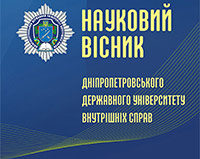Anatolii NATOCHII, Anhelina BABIAK/h2>
NATOCHII A., BABIAK (2022) A., Some aspects of training of police officers for actions related to arrest of an offender and execution of official powers related to the use of firearms, Scientific Bulletin of Dnipropetrovsk State University of Internal Affairs, №4, 381-385
DOI: 10.31733/2078-3566-2022-4-381-385
ABSTRACT. This work reveals some aspects of the preparation of police officers for the preparation of actions to detain a criminal in a confined space. The technical and tactical actions used during the detention of the offender are considered. To fulfill these duties, the Law of Ukraine «On the National Police» empowers the police officer to exercise any rights provided for by this Law, including the right to use and use firearms. So, a policeman, no matter what position he holds, no matter what duties he performs. Of course, the main and most reliable way to protect against an attack by an armed enemy is the ability to use a personal weapon in a timely manner.
The main defensive actions in situations where the use of personal firearms for protection is not possible are wasted, evasion in combination with repulsion with the hand with the weapon, strikes followed by the use of pain techniques or throws. Pistol, the employee must ensure that the weapon is always pointed in a safe direction for himself and others. As a rule, an armed attack consists of a number of actions: threats, approaching, pointing a weapon and its direct use, that is, firing a shot. To achieve a positive result, a necessary condition is psychological stability in extreme situations. If your level of training is high and you perform techniques flawlessly, your actions automatically become habitual and your psyche becomes stable at a distance and fully control your actions.
The effectiveness of disarming the enemy depends on choosing a favorable moment of the attack and largely depends on the ability to feel the moment, the distance, the position of the hand with the weapon, etc. The speed of movement plays a big role in this. Even if the favorable moment of the attack is chosen tactically correctly, the slow movements of the employee can provoke the opponent and give him the opportunity to react in response – to make a shot before physical contact.
Keywords: police officer, confined space conditions, hand-to-hand combat, service activities, tactics, equipment, detention, firearms.
References
- Pro zatverdzhennia Polozhennia pro orhanizatsiiu sluzhbovoi pidhotovky pratsivnykiv Natsionalnoi politsii Ukrainy [On the approval of the Regulation on the organization of official training of employees of the National Police of Ukraine] : nakaz Ministerstva vnutrishnikh sprav Ukrainy vid 26.01.2016 r. № 50. URL: https://zakon.rada.gov.ua/laws/show/z0260-16#Text. [in Ukr.].
- Yurchuk, Yu. H., Matsyshyn, M. O., Lopatkin, I. V. (2017) Metodychni rekomendatsii shchodo zaluchennia kursantiv do orhanizatsii i provedennia zaniat z vohnevoi pidhotovky [Methodological recommendations for the involvement of cadets in the organization and conduct of fire training classes]. Zbirnyk naukovykh pratsʹ Natsionalʹnoyi akademiyi Derzhavnoyi prykordonnoyi sluzhby Ukrayiny. Seriia : Pedahohichni nauky. № 4, pp. 490-498. [in Ukr.].
- Lopayeva, O. M. (2009) Vykonannia vprav strilby z boiovoi zbroi na zaniattiakh z vohnevoi pidhotovky v Akademiyi mytnoi sluzhby Ukrainy [Carrying out firing exercises with combat weapons at fire training classes at the Academy of the Customs Service of Ukraine]. Novyny ot dobrata nauky-2009 : mizhnarodna naukovo-prakt. konf. Bolhariya, Sofiya, 17–25 travnia 2009 r. Vol. 15. URL: http://www.rusnauka.com/15_NPN_2009/Psihologia/46757.doc.htm/ [in Ukr.].
- Hidenko, Ye. S. (2017) Suchasnyi pidkhid do navchannia politseiskykh diiam v ekstremalnykh umovakh [A modern approach to training police actions in extreme conditions]. Pravovi novely. № 3, pp. 82-87. [in Ukr.].
- Kaznacheiev, D. H., Lopayeva, O. M. (2018) Osoblyvosti formuvannia psykholohichnoi stiikosti i hotovnosti pratsivnykiv politsii u protsesi navchannia z vohnevoi pidhotovky [Peculiarities of the formation of psychological stability and readiness of police officers in the process of fire training]. Naukovyi visnyk Dnipropetrovskoho derzhavnoho universytetu vnutrishnikh sprav. № 4, pp. 82-85. [in Ukr.].
- Butov, S. Ye., Reshko, S. M., Yemchuk, O. I. (2013) Teoretychni ta praktychni aspekty taktychnoi pidhotovky pratsivnykiv politsii do zastosuvannia zakhodiv fizychnoho vplyvu ta vohnepalnoi zbroi v ekstremalnykh sytuatsiiakh pid chas vykonannia sluzhbovykh oboviazkiv [Theoretical and practical aspects of tactical training of police officers for the use of measures of physical influence and firearms in extreme situations during the performance of official duties]. Yurydychna psykholohiya ta pedahohika. № 2, pp. 102-114.
- Navchannya na osvitniy platformi LEEd CEPOL [Training on the LEEd CEPOL educational platform]. URL : https://www.naiau.kiev.ua/mizhnarodni-vidnosini/cepol/zagalni-vidom.html. [in Ukr.].
- Semeniuk, V. I., Lavrov, O. Yu, Hryshyn, M. V. ta in. (2015) Kompleksnyi pidkhid do navchannia vohnevii pidhotovtsi z vykorystanniam innovatsiinykh tekhnolohii [A comprehensive approach to fire training training using innovative technologies]. Systemy ozbroiennia i viiskova tekhnika. № 1, pp. 186-190. [in Ukr.].
- Viyskova psykholohiya i pedahohika [Military psychology and pedagogy] : pidruch. / red. L. A. Snihur. Lutsk : Tverdynia, 2010. 576 p. [in Ukr.].
- Vohneva pidhotovka [Fire training] : navch. posib. 2-e vyd., pererob. i dopov. / kol. avt. ; za zah. red. kand. yuryd. nauk, dots. V. Ya. Pokaychuka. Dnipro : DDUVS, 2021. 264 p.
- Natochii, A. D., Smal, P. V. (2021) Vohneva pidhotovka – skladova profesiinoi kompetentnosti maibutnikh ofitseriv politsii [Fire training is a component of the professional competence of future police officers]. Naukovyi visnyk Dnipropetrovskoho derzhavnoho universytetu vnutrishnikh sprav. № 4, pp. 329-333. [in Ukr.].
